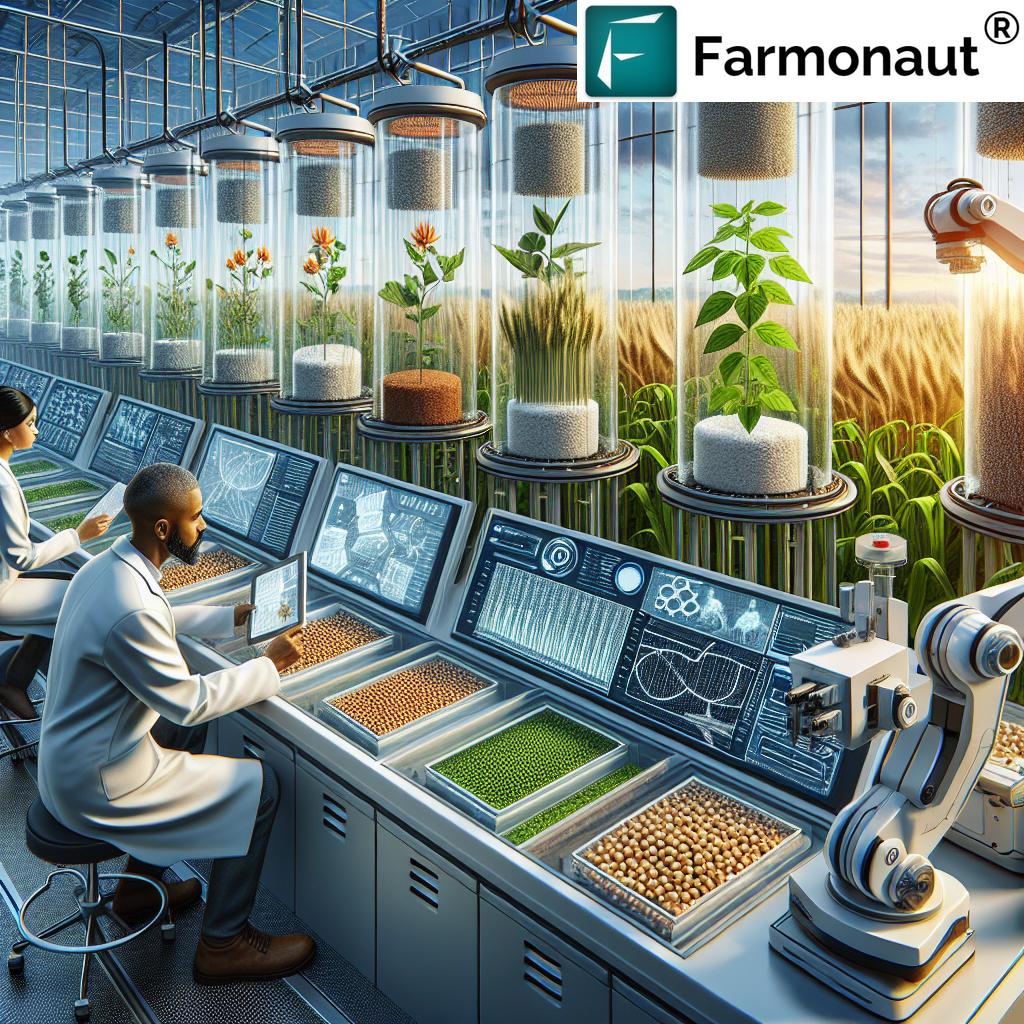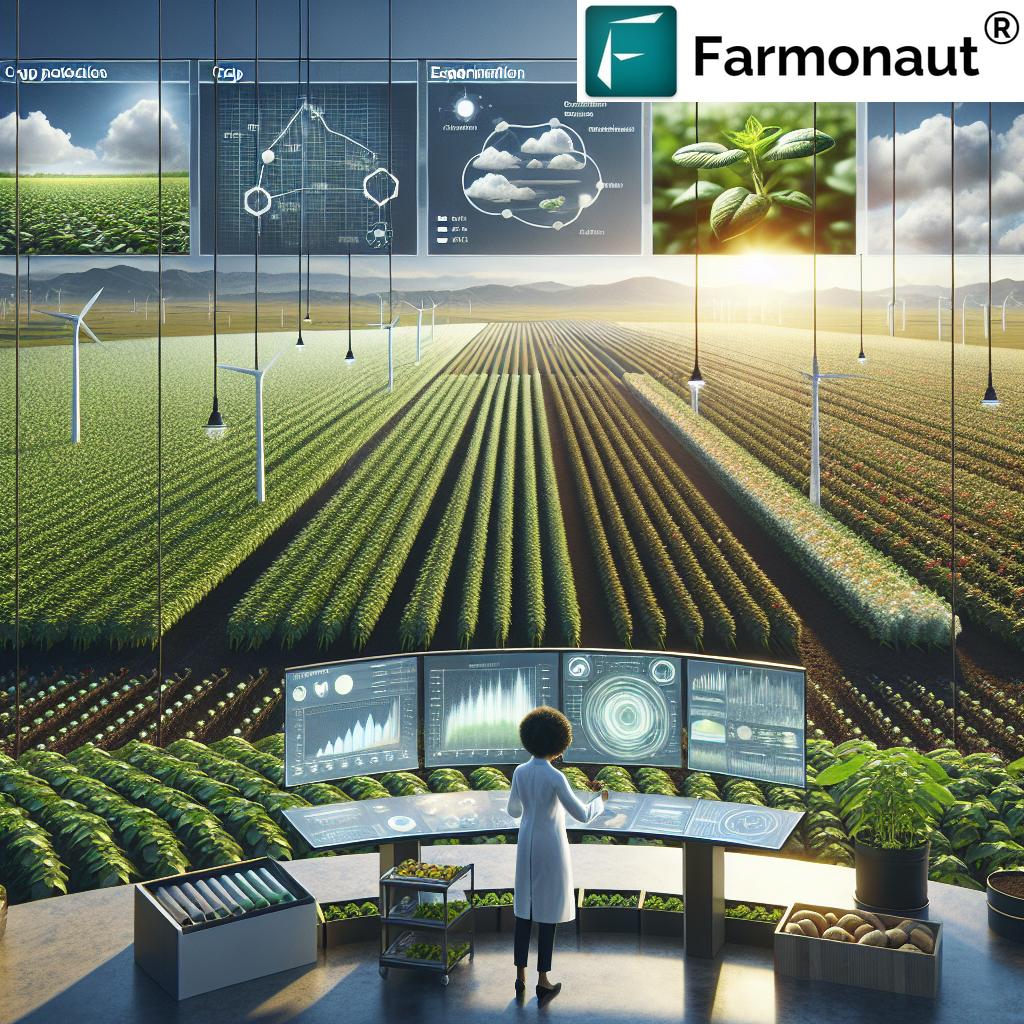Innovative Crop Science: 5 Sustainable Agriculture Techniques Revolutionizing US Farming
In the face of global food security challenges, crop research and sustainable agriculture techniques are at the forefront of innovation. As we delve into the world of cutting-edge plant breeding and precision agriculture technology, we’ll explore how these advancements are shaping the future of farming in the United States and beyond. From drought-resistant crops to enhanced soil health optimization, scientists are tackling the impacts of climate change on agriculture head-on.

“Silicon-enhanced crops can increase plant resilience by up to 20% against environmental stresses.”
In this comprehensive exploration, we’ll highlight groundbreaking research, including silicon’s role in boosting plant resilience, advancements in soybean seed germination, and the creation of longer-storing potatoes through increased calcium content. These innovations in agricultural water management and crop disease prevention are crucial for sustainable food production methods. Let’s dive into the five sustainable agriculture techniques that are revolutionizing US farming and shaping a more resilient future for our food systems.
1. Drought-Resistant Crop Breeding: A Game-Changer in Water Conservation
As climate change continues to impact weather patterns across the US, drought-resistant crop breeding has emerged as a critical sustainable agriculture technique. Plant breeders and crop scientists are developing varieties that can thrive with less water, ensuring food security even in challenging conditions.
- Genetic Modification: Using advanced genetic techniques to identify and enhance drought-tolerant traits in crops like corn, soybeans, and wheat.
- Traditional Crossbreeding: Combining traits from naturally drought-resistant plant varieties to create hardier crops.
- Root System Enhancement: Developing crops with deeper, more extensive root systems to access water in lower soil layers.
The impact of drought-resistant crops extends beyond water conservation. These innovative varieties also contribute to:
- Reduced irrigation needs, saving both water and energy
- Increased crop yields in water-stressed regions
- Greater farmer resilience to unpredictable weather patterns
By implementing drought-resistant crop varieties, US farmers can significantly improve their crop yield improvement strategies while adapting to the challenges posed by climate change.
2. Precision Agriculture Technology: Maximizing Efficiency Through Data
Precision agriculture technology is transforming the way US farmers manage their crops, soil, and resources. By leveraging data-driven insights, farmers can make more informed decisions, leading to improved yields and reduced environmental impact.
Key components of precision agriculture include:
- Satellite Imaging: High-resolution satellite imagery provides detailed insights into crop health, soil moisture, and potential issues.
- GPS-Guided Equipment: Tractors and other machinery use GPS technology for precise planting, fertilization, and harvesting.
- Soil Sensors: In-field sensors monitor soil health, moisture levels, and nutrient content in real-time.
- Drone Technology: Drones equipped with multispectral cameras offer detailed aerial views of crops, helping identify problem areas quickly.
The benefits of precision agriculture are numerous:
- Optimized resource use, reducing waste and environmental impact
- Increased crop yields through targeted interventions
- Improved farm profitability by minimizing input costs
- Enhanced ability to adapt to changing weather conditions
Farmers can access many of these precision agriculture tools through platforms like Farmonaut, which offers satellite-based farm management solutions. Try Farmonaut’s web app to experience the power of precision agriculture firsthand.

3. Soil Health Optimization: The Foundation of Sustainable Farming
Healthy soils are the cornerstone of sustainable agriculture. US farmers are increasingly adopting techniques to improve soil health, leading to better crop yields, increased resilience to climate change, and enhanced environmental stewardship.
“Calcium-enriched potatoes developed through crop science can extend storage life by 30-50% compared to regular varieties.”
Key soil health optimization strategies include:
- Cover Cropping: Planting cover crops between growing seasons to prevent erosion, improve soil structure, and increase organic matter.
- No-Till Farming: Minimizing soil disturbance to preserve soil structure and beneficial microorganisms.
- Crop Rotation: Alternating crops to break pest cycles, improve nutrient cycling, and enhance soil biodiversity.
- Organic Matter Management: Incorporating compost and crop residues to boost soil fertility and water retention.
The benefits of optimizing soil health are far-reaching:
- Increased water retention, reducing irrigation needs
- Enhanced nutrient cycling, leading to reduced fertilizer use
- Improved crop resilience to pests and diseases
- Carbon sequestration, contributing to climate change mitigation
By focusing on soil health, US farmers are not only improving their crop yields but also contributing to long-term environmental sustainability.
4. Silicon-Enhanced Plant Resilience: A New Frontier in Crop Protection
Recent research has unveiled the potential of silicon in enhancing plant resilience against various environmental stresses. This innovative approach is gaining traction among US farmers as a sustainable method to protect crops and improve yields.
The benefits of silicon-enhanced plant resilience include:
- Improved Drought Tolerance: Silicon helps plants retain water more efficiently, reducing drought stress.
- Enhanced Disease Resistance: Silicon strengthens cell walls, making plants more resistant to fungal and bacterial infections.
- Increased Salt Tolerance: Silicon helps plants cope with high salinity levels in soil and water.
- Better Nutrient Uptake: Silicon improves the plant’s ability to absorb and utilize essential nutrients.
Implementing silicon-enhanced plant resilience techniques can lead to:
- Reduced need for chemical pesticides and fungicides
- Improved crop yields in challenging environmental conditions
- Enhanced food quality and nutritional value
- Increased farmer profitability through reduced input costs
As research in this area continues to advance, silicon-enhanced plant resilience is poised to become a key component of sustainable agriculture practices across the US.
5. Advanced Seed Germination Methods: Jumpstarting Crop Success
Innovative seed germination techniques are revolutionizing the way US farmers start their crops. These methods aim to improve germination rates, enhance seedling vigor, and ultimately lead to stronger, more productive plants.
Key advanced seed germination methods include:
- Seed Priming: Controlled hydration of seeds to initiate metabolic processes before planting.
- Seed Coating: Applying protective and nutrient-rich coatings to seeds for improved germination and early growth.
- Electromagnetic Seed Treatment: Using electromagnetic fields to stimulate seed metabolism and enhance germination.
- Nanotechnology: Applying nanoparticles to seeds to improve water uptake and nutrient absorption.
The benefits of these advanced seed germination methods are significant:
- Faster and more uniform crop emergence
- Improved seedling survival rates in challenging conditions
- Enhanced early season growth, leading to better yields
- Reduced need for replanting, saving time and resources
By adopting these innovative seed germination techniques, US farmers can give their crops a strong start, setting the stage for successful harvests.

Comparing Sustainable Agriculture Techniques
| Technique | Primary Benefit | Crop Types Impacted | Environmental Impact | Implementation Complexity | Estimated Yield Improvement |
|---|---|---|---|---|---|
| Drought-Resistant Crop Breeding | Water Conservation | Corn, Soybeans, Wheat | High | Medium | 10-25% |
| Precision Agriculture Technology | Resource Optimization | All Crops | Medium | High | 15-30% |
| Soil Health Optimization | Long-term Sustainability | All Crops | High | Medium | 20-35% |
| Silicon-Enhanced Plant Resilience | Stress Tolerance | Grains, Vegetables | Medium | Low | 10-20% |
| Advanced Seed Germination Methods | Improved Crop Establishment | All Crops | Low | Medium | 5-15% |
This comparison highlights the diverse approaches to sustainable agriculture and their potential impacts on US farming. Each technique offers unique benefits and can be adapted to different crop types and farming contexts.
The Role of Technology in Sustainable Agriculture
As we’ve explored these innovative techniques, it’s clear that technology plays a crucial role in advancing sustainable agriculture. Platforms like Farmonaut are at the forefront of this technological revolution, offering farmers powerful tools to implement and optimize these sustainable practices.
Farmonaut’s satellite-based farm management solutions provide real-time insights into crop health, soil moisture levels, and weather patterns. This data-driven approach enables farmers to make informed decisions about irrigation, fertilizer usage, and pest management, aligning perfectly with the principles of precision agriculture and sustainable farming.
Key features of Farmonaut’s technology include:
- Real-time crop health monitoring using satellite imagery
- AI-powered advisory systems for personalized farm management
- Weather forecasting and historical data analysis
- Resource management tools for optimizing water and fertilizer use
By leveraging these advanced technologies, US farmers can more effectively implement the sustainable agriculture techniques we’ve discussed, leading to improved crop yields, reduced environmental impact, and increased profitability.
Explore Farmonaut’s capabilities:
API Access | API Developer Docs


The Future of Sustainable Agriculture in the US
As we look to the future, it’s clear that the integration of these sustainable agriculture techniques will play a pivotal role in shaping US farming practices. The challenges posed by climate change, population growth, and resource scarcity necessitate a continued focus on innovation and sustainability in agriculture.
Key trends to watch in the coming years include:
- Increased Adoption of AI and Machine Learning: These technologies will further enhance precision agriculture, enabling more accurate predictions and recommendations for farm management.
- Expansion of Vertical Farming: Urban agriculture solutions will become more prevalent, addressing food security issues in cities and reducing transportation costs.
- Integration of Renewable Energy: Solar and wind power will increasingly be used to power farm operations, reducing reliance on fossil fuels.
- Development of Climate-Resilient Crop Varieties: Ongoing research will lead to crops that can thrive in a wider range of environmental conditions.
- Emphasis on Soil Health and Carbon Sequestration: Farming practices that improve soil health and capture carbon will become increasingly important in combating climate change.
As these trends continue to evolve, the role of technology in supporting sustainable agriculture will only grow. Platforms like Farmonaut will be instrumental in helping farmers adapt to these changes and implement new sustainable practices effectively.
Conclusion: Embracing Innovation for a Sustainable Future
The five sustainable agriculture techniques we’ve explored – drought-resistant crop breeding, precision agriculture technology, soil health optimization, silicon-enhanced plant resilience, and advanced seed germination methods – represent just the beginning of a new era in US farming. By embracing these innovations and leveraging cutting-edge technologies, farmers can address the challenges of climate change, improve crop yields, and ensure food security for future generations.
As we move forward, it’s crucial for farmers, researchers, and policymakers to work together in advancing these sustainable agriculture practices. By doing so, we can create a more resilient, productive, and environmentally friendly agricultural sector in the United States and beyond.
The journey towards sustainable agriculture is ongoing, and each step forward brings us closer to a future where farming not only feeds the world but also nurtures and protects our planet. As we continue to innovate and adapt, the promise of a sustainable and bountiful agricultural future grows ever brighter.
FAQ Section
- Q: What is sustainable agriculture?
A: Sustainable agriculture refers to farming practices that meet current food needs while preserving the ability of future generations to meet their own needs. It involves techniques that conserve resources, protect the environment, and maintain economic viability. - Q: How does precision agriculture contribute to sustainability?
A: Precision agriculture uses technology to optimize resource use, reducing waste and environmental impact. It allows farmers to apply water, fertilizers, and pesticides only where and when they’re needed, improving efficiency and crop yields. - Q: Can drought-resistant crops completely eliminate the need for irrigation?
A: While drought-resistant crops significantly reduce water requirements, they don’t eliminate the need for irrigation entirely. These crops are better at tolerating water stress but still require some water for optimal growth and yield. - Q: How does soil health optimization benefit the environment?
A: Healthy soils sequester more carbon, reduce erosion, improve water retention, and support biodiversity. This leads to reduced greenhouse gas emissions, improved water quality, and enhanced ecosystem resilience. - Q: Are silicon-enhanced crops considered GMOs?
A: Not necessarily. Silicon enhancement can be achieved through various methods, including soil amendments and foliar applications, without genetic modification. However, some research involves genetically modifying plants to better utilize silicon.




